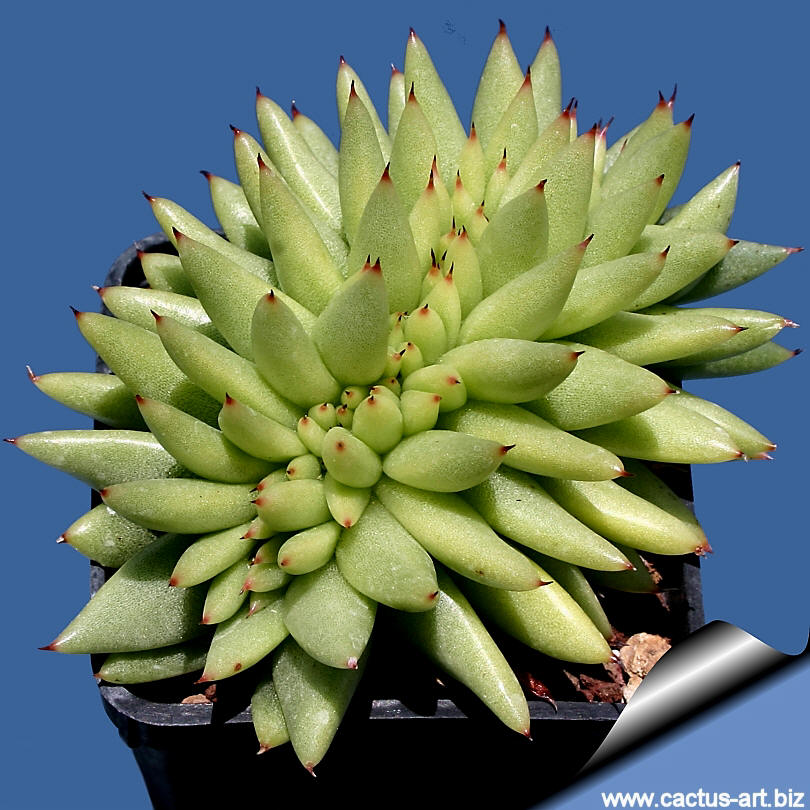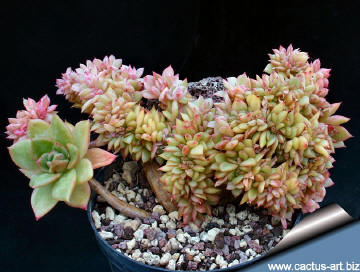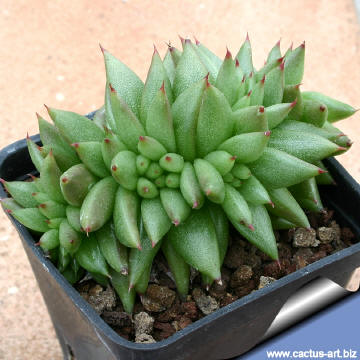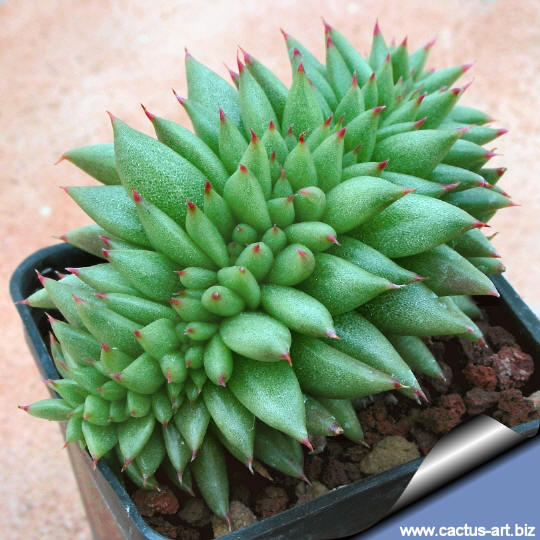|
|
|

Echeveria agavoides
forma cristata.
|
|
Description: The standard Echeveria agavoides is a stemless,
star-shaped rosette of fat leaves up to 20 cm in diameter. It is often
solitary, growing offsets only slowly or not at all. is a variable
plant; some forms have reddish tips and some forms have slightly red to
very red margins. This is a relatively common species, and quite fast
for an Echeveria. It has also been widely used in hybridizing. The
beautiful crested form develops fans of frosty green spikes tipped in
red.
Stem: Very short (almost stem less) 3-5 cm tall, 2,5-3 cm in
diameter.
Leaves: ± 20, ovate-deltoid accuminate, moderately keeled, with
rounded margin, 4-8 cm long, 3 cm wide near base, ± 5 mm thick, satiny
translucent light apple-green that in summer tend to assume a red
colouring. Leaves are at their brightest from autumn to spring. The
leaves shows a well-marked phyllotaxis. Five curves in one direction and
eight curves in the opposite direction (Parastichy number 5-8)
Flowers: Conoid-urceolate, pinkish-red wit petals tipped with
dark yellow on an inflorescence 50 cm tall. Peduncle 8-25 mm long,
Blooming season: Summer.
|
|

Also known as "Crested Molded Wax Agave", this is a thick and
solid-leaved variety of the "House Leek", introduced from Mexico. It
will develop beautiful fans of frosty green spikes tipped in red.
|
 |
|
Photo of conspecific taxa, varieties, forms and cultivars of
Echeveria agavoides.
Advertising
|
|
|
|
|
|
|
Family: Crassulaceae
Scientific name:
Echeveria
agavoides
Lemaire
In: Ill. Hort.
10: Misc. 78. 1863
forma cristata
Origin:
Garden origin (Nursery
produced cultivar)
Conservation status: Listed in
CITES appendix 2.
Common English Names include:
Crested Molded Wax Agave
Etymology: The specific epithet
means “agave like” and the rosettes somewhat resembles the form of an
Agave.
Synonyms:
- Cotyledon agavoides
(Lem) Baker 1869
- Urbinia agavoides
(Lem) Rose 1903
- Echeveria yuccoides
Morren 1874
- Urbinia obscura
Rose 1903
- Echeveria obscura
(Rose) A. berger 1930
|
|
|
|

Cultivation: Echeveria are
easily grown succulents that can tolerate sun, shade, moist soils, dry
soils, but look their best only when given adequate light levels and
water, and ideally should be grown outdoors in full sun. Generally
speaking, the more light a plant gets the better it will display its
colours and shape. Bright light is required to prevent "stretching" of
Echeverias ("stretching" occurs when a moderately fast growing plant
such as an Echeveria, is grown in dim light or over-fertilized, which
causes overly lush growth that contributes to weak, pallid plants).
However, when moving plants from lower light conditions into full sun,
be wary of sun scorch resulting from too rapid a transition into intense
summer sunlight, most easily avoided by ensuring plants are well-watered
before moving them on a cloudy day. Echeveria are able to tolerate
extended dry periods and survive drought without the need for watering,
but they will grow stronger if they receive adequate moisture during
their growing season, but never allowing the plant to remain waterlogged
(root rot sensitive). For this reason, it is essential in cultivation to
use a very porous soil, which will allow quick drainage. Avoid overhead
watering under humid conditions, especially during winter. Echeveria are
shallow rooted plants, and therefore benefit from good levels of organic
matter in the soil. Give it enough root space for optimum growth. Slow
release fertilisers with a low to moderate nitrogen content incorporated
into the potting mix are usually adequate for the spring and summer
growing seasons of Echeveria, and additional fertiliser applications
would not normally be required until spring. Good air movement is
important for minimising pest and disease risks, and avoiding excessive
humidity in cool winter conditions is important to successfully growing
Echeveria in the nursery environment. Can tolerate light frosts.
however, the ideal temperature range during the summer growing season is
5-25°C, with the cooler autumn temperatures tending to make their
foliage colours become more intense than those of the active summer
growing season. Aphids like this plant (and all flowering Echeverias).
Propagation: Very easy to
propagate usually by division of larger clumps.


|
|